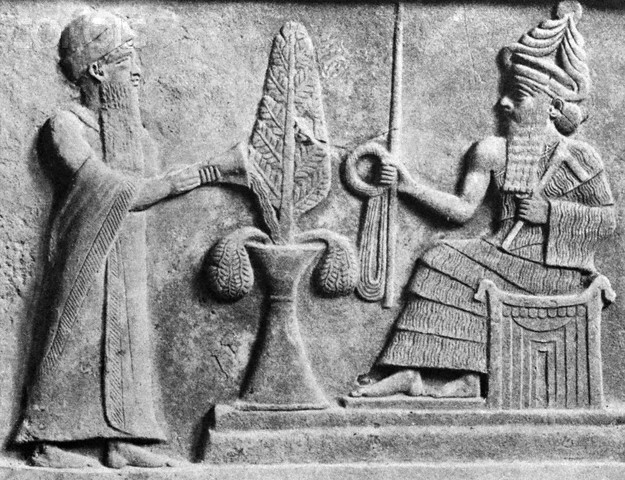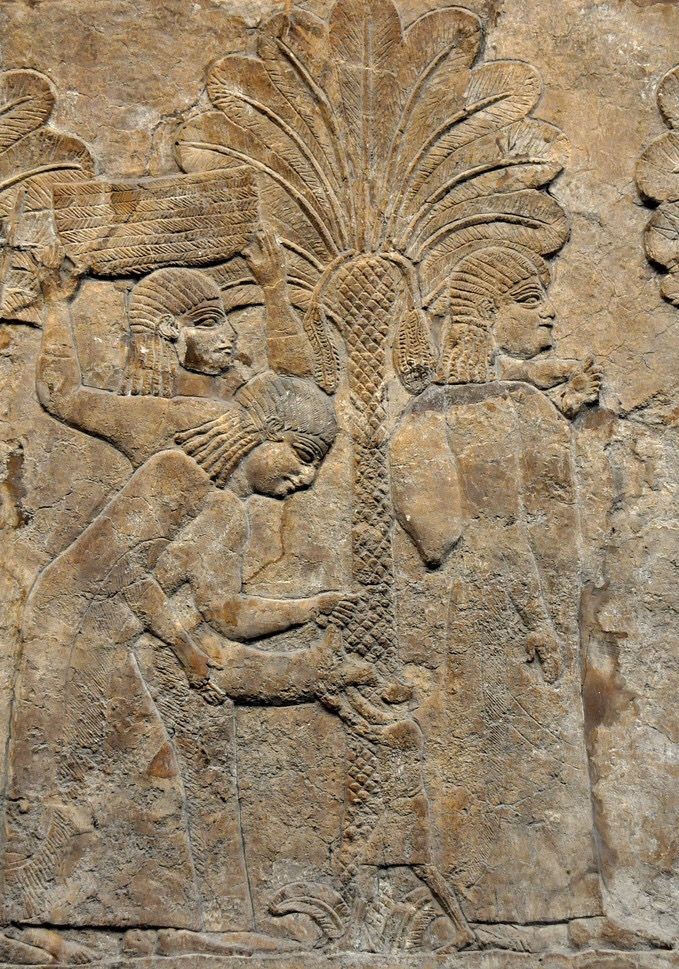Ancient Psychedelia: Alien Gods & Mushroom Goddesses
Online Book - Chapter 3, Page 49
Back to Online Book Mainpage / Next Page (Chapter 3, Page 50)
L: (24f) A Stele of Two Deities with Sacrificial Tree c. 2060 BC  R: (16 l) Aramean steles c. 800-400 BC The wide variety of iconography in fertility alone, led to many various expressions including the tree of life as the outgrowth of the child from the placenta. Mahe-Maya, Buddha’s mother held onto the branch of a Sal tree when she was giving birth. In Asian legend it was said that a woman had to sleep alone or roll around under an apple tree to get pregnant. (9) Allegro further elucidates ancient conceptions of life and the universe, as they relate to the mushroom: “They saw the whole universe as a monster mushroom, the earth as the lower “cup” of the vulva, the heaven stretched out above as a great pilleus, supported on a pillar of some sacred mountain. Out of this conception came stories of giants holding up the canopy of heaven, and another source of folk-names and mythology of the mushroom.” (10) The Pomegranate The pomegranate has been named as a fertility symbol by many authors over the years. It is my belief that this is due to the pomegranate’s similarity to the mushroom, especially in color, just as the apple is. Since it has many seeds, this is a good reason to include it to symbolize the fertility of the mushroom just as the earth born snakes do, emerging from the ground. The pomegranate, like the apple, is a symbol for the mushroom, wherever it is used in myth and folklore. Several goddesses associate with the pomegranate including Kubaba, the Anatolian Hittite goddess, Hera and Aphrodite, all of whom wore tiaras made from its branches, with leaves still attached. Pomegranate branch tiaras were also popular among Demeter’s priests in Eleusis. Eusebios claimed that the pomegranate and opium poppy together represented fertility. (11) Demeter eats the pomegranate when she is tricked by Hades and this consumes her marriage with him and forces her departure for part of the year. Many times a red object will imply the mushroom because the A. muscaria cap is red. The Earth Mother The central theme of the spiritual/religious foundation of worship in the ancient world has always been the sanctity of the earth, the sky, thunderclouds, rain and essentially everything related to nature. Represented as the “Great Mother.” The goddess rites, therefore, found a home in most villages represented as the primary deity worshiped under various names, such as Mata, Amba, Amma, Kali, Rati, etc. (12) |
In the Minoan-Mycenaean culture one can clearly see the focus on the earth mother as the predominant deity, and the male god was subordinate, whereas, in later Greek culture under the Olympian pantheon, the sky father or thunder-god Zeus was dominant. This is one of the areas one can see how the transition to patriarchy occurred. (13) The Birth of the “Divine Child” Graves asserts that the origin of the “Divine Child” may be traced to early Minoan Crete. (14) The concept of the Divine Child is an ancient one tracing back to fertility rites and celebrations and existed long before there ever was an idea of a Christ figure. The Divine Child represents the new springing vegetation or perhaps even the emergence of the mushroom. There have been a few personalities who have fulfilled the role of the divine child throughout history and they usually share certain characteristics such as being born autochthonous, (self-born, virgin birth) from the earth or soil. Erichthonius of Athens was one of these such deities. The serpent was his symbol, and according to legend, Athena hid him in a chest together with snakes and gave the chest in guardianship to three maidens. Aglauros, “the bright one,” Pandrosus, “the Dewy one” and Herse “Dew.” Pandrosus was known as the “Dew Goddess” and the three Kekropidai together are sometimes referred to as the “Dew Sisters.” (15) She warned them never to open the chest but they did, and when they saw the sight of the infant, they went insane. Some legends recount that the infant was half serpent-half man. The Dying & Resurrected God The concept of the dying god, the sacrificed child or the resurrected god can all be traced back to early Old European forested culture. Wood carving traditions going back thousands of years saw portrayals of the dying or worrying god, the original spirit of vegetation. These have been kept preserved in family collections for millennia. This tradition has come down to us clearly in the imagery of Jesus Christ in Christianity. (16) (9) Mythology and Symbols of the Mother Goddess, p. 156; (A. Inan, "Makaleler ve incelemeler". Ank. 1987, p. 132. Also see: B. Ogel, "Turk Mitolojisi". p. 506). (10) The Sacred Mushroom and the Cross, p. 132 (11) Mythology and Symbols of the Mother Goddess, p. 191; (P.E. Eusebios, 3, 11.6 den see G. Thomson. Tarih Oncesi Ege. 3. baski. 1st 1995, p. 24). (12) The Cult of the Mother Goddess, p. 113-14 (13) The Cult of the Mother Goddess, p. 144 (14) The White Goddess, p. 318 (15) Goddesses and Gods of Old Europe, p. 235; (Evy Johanne Haland, "The Ritual Year of Athena: The Agricultural Cycle of the Olive, Girls' Rites of Passage, and Official Ideology," Journal of Religious History 36, no. 2 (June 2012): 261) (16) The Language of the Goddess, p. 183 |
Go Back to Page 48